

TLF livre blanc CRM/GRC. Historique de la relation client. Depuis le début de l'outsourcing, donneurs d'ordres et acteurs de la relation client travaillent main dans la main, dans une logique de partenariat.

7612_Intro. Social CRM : l’impact des réseaux sociaux dans la stratégie relation client des entreprises. Les 5 mythes de fidélisation des clients ! J’ai renoncé à lire tous les livres écrits sur la satisfaction clients, la fidélité, la loyauté, la qualité de service, les services clients gagnants qui paraissent.

Je suis inscrit à des sites/blogs qui m’envoient tous les jours des « livres / articles / best Sellers » qui nous disent que nous devons « dépasser » les attentes des clients, atteindre la « delight expérience », créer l’effet « Waouh ! Le client sera augmenté (Tendances relation client 2014 - 3/10) Objets connectés "Une nouvelle forme de management 2.0" Ils devraient être 30 milliards dans le monde d’ici 2020 pour un chiffre d’affaire frôlant les 2000 milliards de dollars, les objets connectés semblent être au cœur des innovations de demain (Cabinet d’études Gartner).
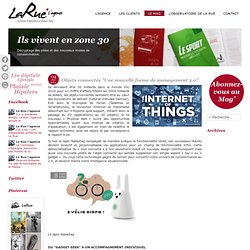
Exit donc le monopole de l’écran (Tablettes et Smartphones), la révolution Internet se matérialise désormais sur n’importe quel support, initiant donc le passage du 2D (applications) au 3D (objets). Si ce nouveau « Physical Web » ouvre des opportunités exponentielles quant aux champs de création & d’application, il est également en train de redéfinir le rapport entretenu avec les objets et par conséquence le rapport à soi. Si hier le lapin Nabaztag remplaçait de manière ludique la fonctionnalité réveil, son successeur Karotz devient évolutif et personnalisable via applications pour un champ de fonctionnalité infini. What is Internet of Things (IoT)? - Definition from WhatIs.com. The Internet of Things (IoT) is an environment in which objects, animals or people are provided with unique identifiers and the ability to transfer data over a network without requiring human-to-human or human-to-computer interaction.
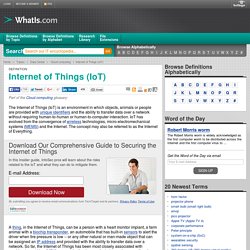
IoT has evolved from the convergence of wireless technologies, micro-electromechanical systems (MEMS) and the Internet. The concept may also be referred to as the Internet of Everything. In this Insider guide, InfoSec pros will learn about the risks related to the IoT and what they can do to mitigate them. A thing, in the Internet of Things, can be a person with a heart monitor implant, a farm animal with a biochip transponder, an automobile that has built-in sensors to alert the driver when tire pressure is low -- or any other natural or man-made object that can be assigned an IP address and provided with the ability to transfer data over a network.
IPv6’s huge increase in address space is an important factor in the development of the Internet of Things. Online Consumer Behavior: How is Web 2.0 Changing Consumer Behavior? Web 2.0 describes how consumers and businesses behave and participate in this current market on the web.
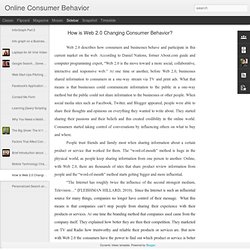
According to Daniel Nations, former About.com guide and computer programming expert, “Web 2.0 is the move toward a more social, collaborative, interactive and responsive web.” At one time or another, before Web 2.0, businesses shared information to consumers in a one-way stream via TV and print ads. What that means is that businesses could communicate information to the public in a one-way method but the public could not share information to the businesses or other people.
When social media sites such as Facebook, Twitter, and Blogger appeared, people were able to share their thoughts and opinions on everything they wanted to write about. “From Consumer to Prosumer to Produser: Who Keeps Shifting My Paradigm? (We Do!)” in Volume 21, Number 3. Claudia K.
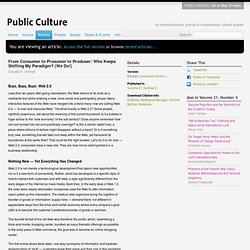
Grinnell Buzz, Buzz, Buzz: Web 2.0. Introduction à la Gestion de la Relation Client (GRC / CRM) - CRM : Customer Relationship Management. A Brief History of Customer Relationship Management. CRM hasn’t always been the robust, stand-alone software that so many businesses rely on today.
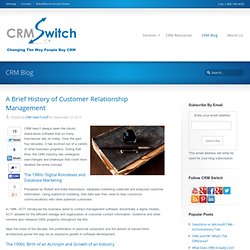
Over the past four decades, it has evolved out of a variety of other business programs. During that time, the CRM industry has undergone sea-changes and shakeups that could have derailed the entire concept. The 1980s: Digital Rolodexes and Database Marketing Pioneered by Robert and Kate Kestnbaum, database marketing collected and analyzed customer information. Using statistical modeling, that data was then used to help customize communications with other potential customers.
Moving Beyond the Customer Database. Customer Relationship Management (CRM) is one of those magnificent concepts that swept the business world in the 1990’s with the promise of forever changing the way businesses small and large interacted with their customer bases.

In the short term, however, it proved to be an unwieldy process that was better in theory than in practice for a variety of reasons. First among these was that it was simply so difficult and expensive to track and keep the high volume of records needed accurately and constantly update them. In the last several years, however, newer software systems and advanced tracking features have vastly improved CRM capabilities and the real promise of CRM is becoming a reality.
As the price of newer, more customizable Internet solutions have hit the marketplace; competition has driven the prices down so that even relatively small businesses are reaping the benefits of some custom CRM programs. In the beginning… Database marketing. Is a form of direct marketing using databases of customers or potential customers to generate personalized communications in order to promote a product or service for marketing purposes.
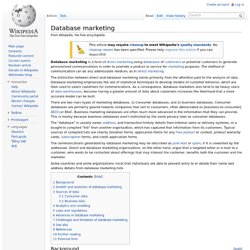
The method of communication can be any addressable medium, as in direct marketing . The distinction between direct and database marketing stems primarily from the attention paid to the analysis of data. Database marketing emphasizes the use of statistical techniques to develop models of customer behavior, which are then used to select customers for communications. As a consequence, database marketers also tend to be heavy users of data warehouses , because having a greater amount of data about customers increases the likelihood that a more accurate model can be built. There are two main types of marketing databases, 1) Consumer databases, and 2) business databases.
The communications generated by database marketing may be described as junk mail or spam , if it is unwanted by the addressee.